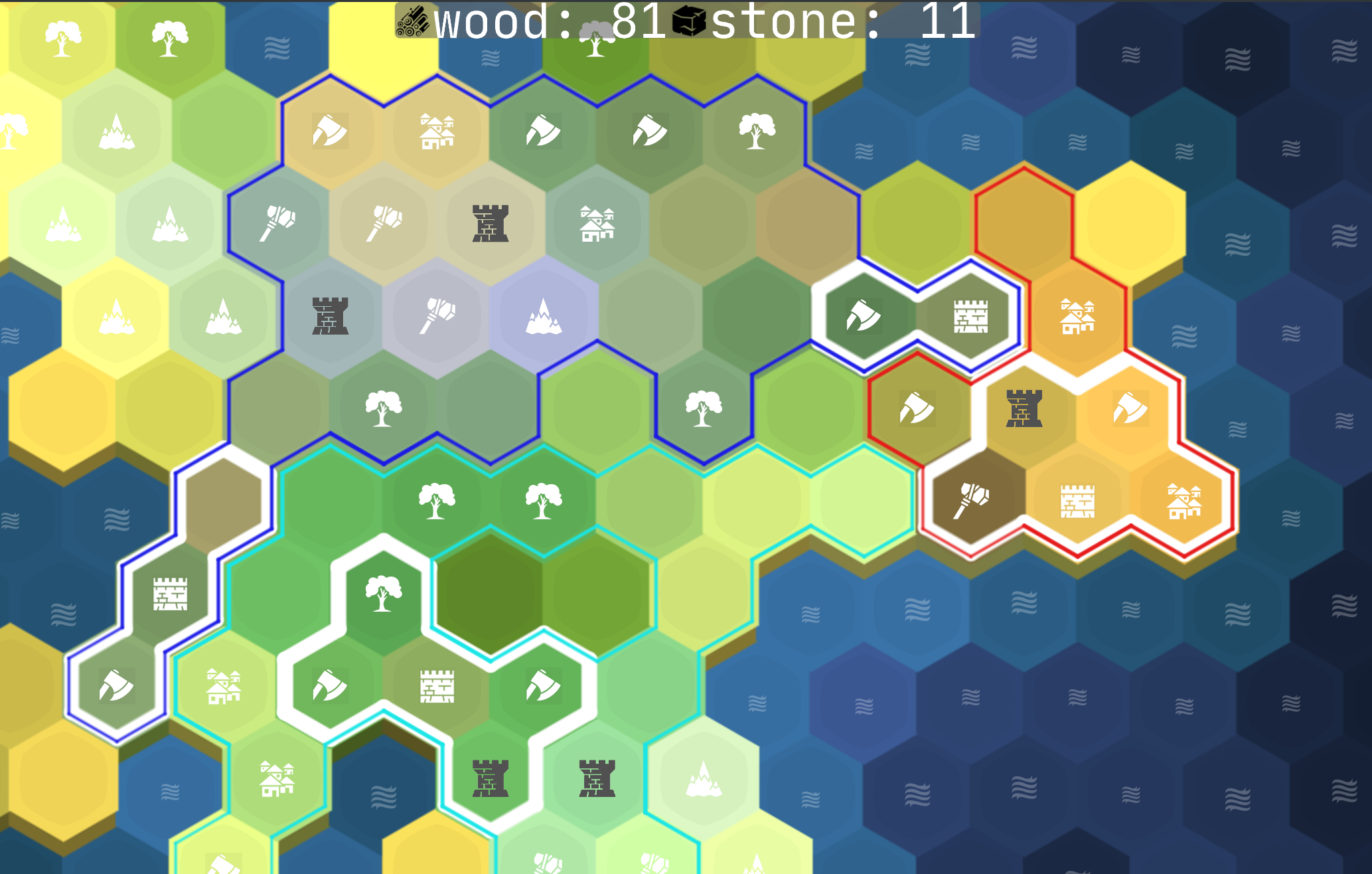Is it easy to draw a line
Demo Note that for some reason on the web it's not that good as on the desktop (mb I'll write another note later). I also had to turn off browser's AA manually.
Wait what?
If you just draw rectangle in OpenGL you'll notice that the edges look like a pixel ladder. You may try to fix that with MSAA but its still will be poor quality. Also one may want to draw the line not as a rectangle but as a rounded rectangle.
Normal + width
To draw just rectangle lines one can use normal to a segment as a vertex attribute. This approach is well described here
SDF
The other way of drawing high quality segments is using Signed Distance Field (SDF).
That is what I'm using in my game
 We can create smooth edges by calculating the distance to it
(we assume here that there is no thickness of the line).
Also, with SDF we can create a nice rounded segment's ends.
We can create smooth edges by calculating the distance to it
(we assume here that there is no thickness of the line).
Also, with SDF we can create a nice rounded segment's ends.
We also can use that for drawing polygonal chains. (correct me if there is simpler term for this). Unfortunately, we can't just draw these segments on the top of each other, because of transparent edges that will overlap and create ugly blending effect. Or if the line itself is transparent we will just see overlaps. It can be solved with rendering to texture for example.
We will only consider opaque polygonal chains next. (again we can render to texture and then do transparent chains).
Here is the shader we will use for the segment's SDF.
float line_segment(in vec2 p, in vec2 a, in vec2 b) { vec2 ba = b - a; vec2 pa = p - a; float h = clamp(dot(pa, ba) / dot(ba, ba), 0., 1.); return length(pa - h * ba); } ... // later used like lowp float distance = line_segment(pp, a, b) - thickness;
As you can see in fragment shader we need to have segment's ends and thickness. We just pass these parameters as vertex attributes in the vertex shader and then into fragment shader. There are two ways that come to my head to do this:
- Create a buffer with two triangles for each line. Just pass SDF parameters in each Vertex.
- Only create one buffer for a line with two triangles and pass these parameters per line via instancing.
Our line struct will look like this. (segment type is actually discrete value)
#[derive(Debug, Clone, Copy)] #[repr(C)] pub struct Line { pub segment_type: f32, pub position: Vec2, pub thickness: f32, pub dir: Vec2, pub color: Vec3, } impl Line { pub fn new( segment_type: SegmentType, from: Vec2, to: Vec2, thickness: f32, color: Vec3, ) -> Self { let dir = to - from; Line { segment_type: segment_type as u8 as f32, // dirty hack to make OpenGL happy position: (from + to) / 2., thickness, dir, color, } } }
Shaders
I'm not sure if the second way is faster (since the instance is only two triangles -- the overhead is small). But it's convenient and fast enough to draw million of antialiased high-quality lines.
Here is the vertex shader code (sorry for the old glsl version):
#version 100 precision lowp float; attribute vec2 pos; attribute float segment_type; attribute vec2 inst_pos; attribute float thickness; attribute vec2 dir; attribute vec3 color0; varying vec2 local_position; varying vec2 projected_position; varying vec2 ip; varying float th; varying vec4 color; // segment type. Have to pass as float, but it is just enum varying float st; varying vec2 dr; uniform mat4 mvp; void main() { vec2 n = vec2(-dir.y, dir.x) / length(dir); vec2 apos = pos.y * dir + pos.x * n * thickness; vec4 new_pos = vec4(apos + inst_pos, 0.0, 1.0); vec4 res_pos = mvp * new_pos; gl_Position = res_pos; st = segment_type; local_position = pos; projected_position = vec2(new_pos.x, new_pos.y); ip = inst_pos; dr = dir; th = thickness; color = vec4(color0, 0.5); }
We just change the shape of our line according to these parameters:
- dir: segment direction
- thickness: thickness of the line
and then pass required variables into the fragment shader
Here is the fragment shader:
#version 100 precision lowp float; varying vec2 local_position; varying vec2 projected_position; varying vec2 ip; varying float th; varying vec4 color; varying float st; varying vec2 dr; uniform mat4 mvp; const lowp float aaborder = 0.00445; float line_segment(in vec2 p, in vec2 a, in vec2 b) { vec2 ba = b - a; vec2 pa = p - a; float h = clamp(dot(pa, ba) / dot(ba, ba), 0., 1.); return length(pa - h * ba); } void main() { vec2 a = ip - dr / 2.; vec2 b = ip + dr / 2.; float d = line_segment(projected_position, a, b) - th; float scaled_border = aaborder / mvp[1][1]; float edge1 = -scaled_border; float edge2 = 0.; if (d < 0.) { float smooth = 1.; if (abs(st - 1.) < 0.01 && local_position.y < -0.5) { // in SDF space discard; } else if (abs(st - 2.) < 0.01 && local_position.y > 0.5) { discard; } if (d > edge1) { smooth = 1. - smoothstep(edge1, edge2, d) + st - st; } vec4 color = color; color.a = smooth; gl_FragColor = color; } else { gl_FragColor = vec4(color.xyz, 0.0); } }
First, we do the same operation (create vertex position in world space) as in
vertex shader, but without projection with MVP matrix.
Then we calculate the distance to the borders with our line SDF function.
After that, we want to create a nice antialiased edge.
We pass the distance smoothstep function between edge1 and edge2 and then
pass the result value to the alpha channel of the result line's color.
But what is the segment type (st)?
In order to draw monochromatic polygonal chains with multiple segments we can't
just draw segments with corners on the top of each other.
Because if we do so then our smooth edges will overlap and blend with each other.
Maybe one can solve it with rendering to a texture or some nonstandard blending.
But we will just draw only one segment edge as shown in this picture
 (note that each line has a different color only for demonstration.
We can draw a red line on the top of the yellow. Or clip red line instead of yellow)
(note that each line has a different color only for demonstration.
We can draw a red line on the top of the yellow. Or clip red line instead of yellow)
We have segment type which is a float variable but encodes discrete values
(Maybe I'm missing something
but it's not clear for me how to pass int variables into glsl shaders...
at least for this glsl version:) ):
- Just draw regular segment
- Cut the first end of the segment
- Cut the second end of the segment
if (abs(st - 1.) < 0.01 && local_position.y < -0.5) { // in SDF space discard; } else if (abs(st - 2.) < 0.01 && local_position.y > 0.5) { discard; }
We draw a polygonal chain like this:
for i in 0..stringline_num { let point = vec2(qrand::gen_range(-100., 100.), qrand::gen_range(-100., 100.)); let segment_type = match i { 0 => SegmentType::All, _ => SegmentType::NoFirst, }; lines.add(Line::new(segment_type, prev, point, THICKNESS, color)); prev = point; }
This will produce cutting like a yellow line on the picture.
Our end result will look like this nice monochromatic polygonal lines:

Bonus: Drawing maps
We can use our lib for example to draw the map. I've provided some OSM data here. We just import all data that can be represented as segments and voila here is the map :)

